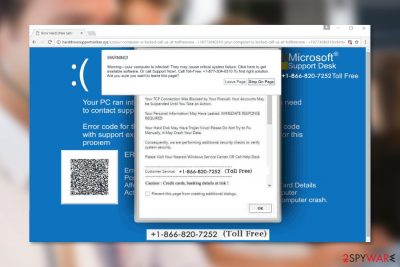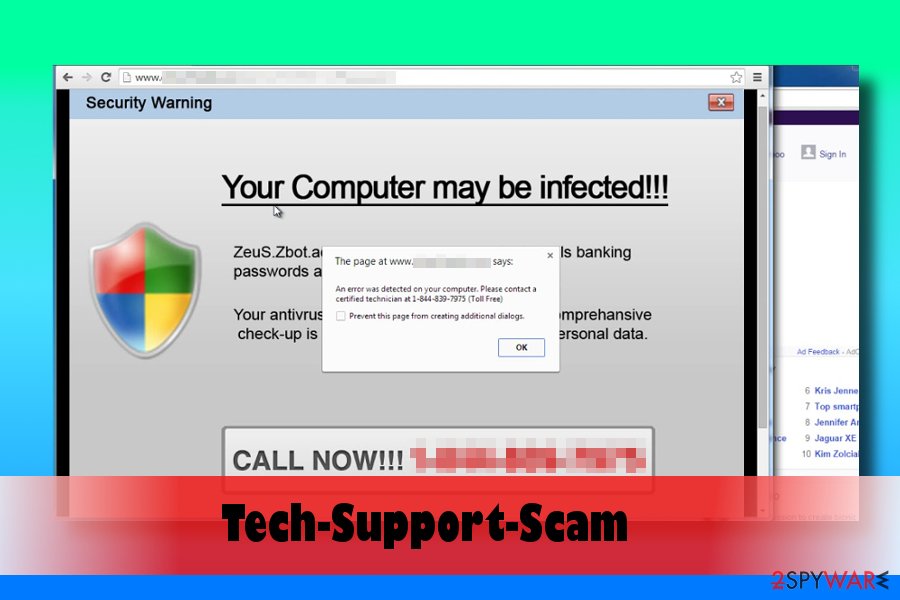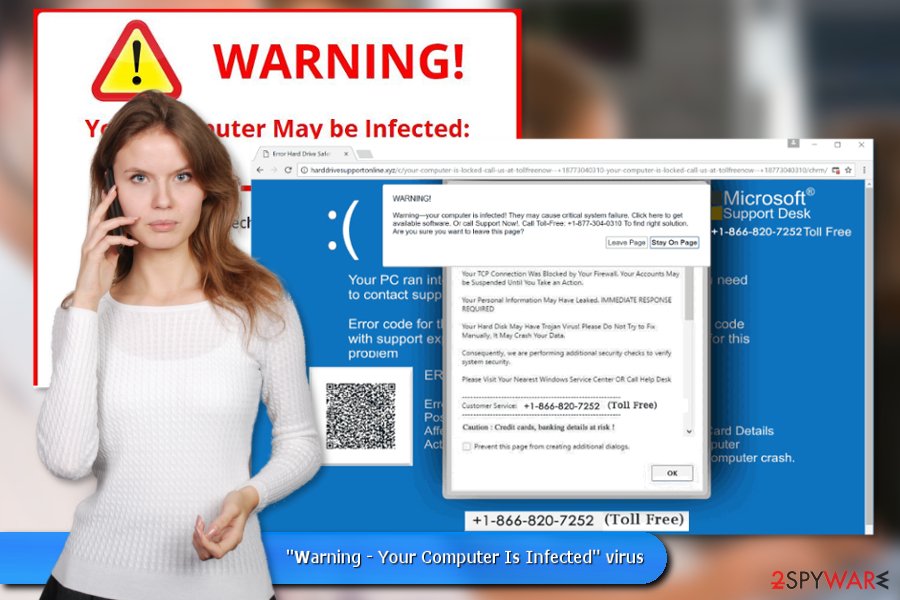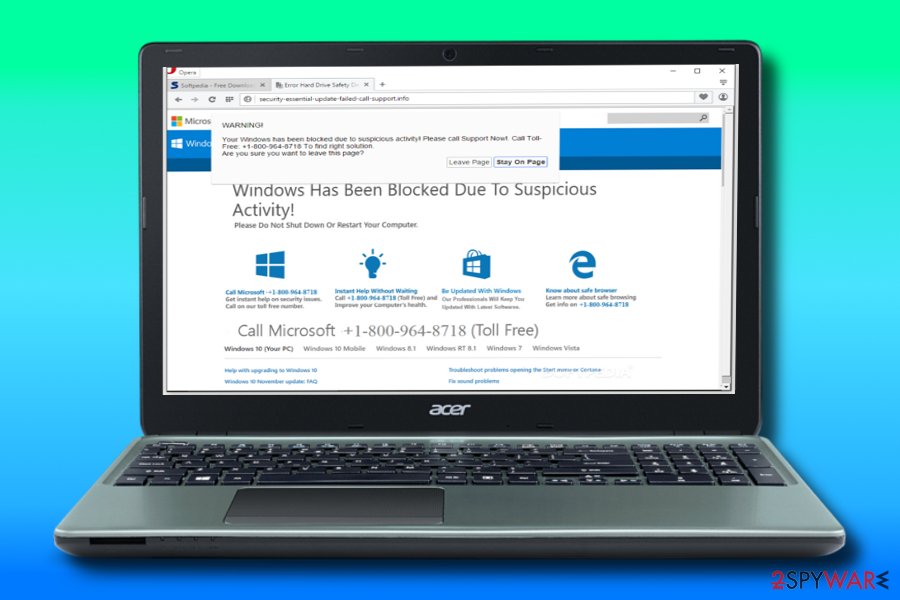“Warning! Your Computer Is Infected” virus (Removal Instructions) - Microsoft Support Scam
“Warning! Your Computer Is Infected” virus Removal Guide
What is “Warning! Your Computer Is Infected” virus?
“Warning – Your Computer Is Infected” is a Tech-Support-Scam alert promoting fake software updates

“Warning – Your Computer Is Infected” hoax is a technical-support-scam[1] alert, which contains false claims about Trojan infection and possible hard drive failure. It mimics the features of a legitimate Microsoft notification and prompt the PC's user to call one of the two Customer Support numbers. However, that's yet another social engineering strategy used to spread malware and initiate other shady activities, so do not fall for calling the crooks. People can be redirected to the fake “Warning – Your Computer Is Infected” site by adware program or JavaScript infected malicious domains.
| Name | Warning – Your Computer Is Infected |
| Malware type | Tech-Support-Scam |
| Causes | Adware infection, malicious websites |
| Distribution | Freeware (bundling) |
| Danger level | Low (it cannot affect the system directly) |
| Symptoms | Web browser's redirects to “Warning – Your Computer Is Infected” new tab, excessive amount of pop-ups and other ads |
| Removal methods | Related adware can be eliminated with FortectIntego. Manual removal instructions provided at the end of the article |
The Your Computer Is Infected scam is displayed in a form of a full page new tab window. It simulates Microsoft Windows BSOD in the background, a bar-code, and two Windows Service Center contact numbers: +1-877-304-0310 and +1-866-820-7252. To intimidate people and trick them into calling them, crooks render bogus claims about unknown Trojan infection in the hard drive, which can lead to leakage of personal information and complete data loss.
However, dialing this phone number is not a good idea for several reasons:
- the phone call might be charged more than a regular call;
- crooks might want to sell you bogus security software;
- scammers might want you to install remote access tools;[2]
- criminals might trick personal information about you.
“Warning – Your Computer Is Infected” virus uses Microsoft’s name and credentials to make this scam look like real notification. When users are redirected to the malicious website, it locks the screen and delivers two pop-up windows. The first notification briefly informs about computer infection, provides support phone number and asks whether you want to leave this page or not.

The second warning message gives more information about the problem. Here crooks name numerous problems that might occur due to this “infection”:
- blocked firewall,
- account suspension,
- leakage of the personal information.
- infiltration of the Trojan.
- the possibility of losing a credit card or banking information.
Authors of the “Warning – Your Computer Is Infected” scam claims that trying to find and delete this “virus” manually may lead to data loss and other problems. They want to make users believe that only “certified technicians” can solve this problem.
However, you should not Google where the nearest Windows Service Centre is or call the provided number. This cyber infection provides false information to involve users into cyber crime. Scanning the system with anti-malware/anti-spyware is recommended to make sure that your computer is not infected with adware that is responsible for spreading the scam. The program, such as FortectIntego, will help to remove “Warning – Your Computer Is Infected” easily and protect your device from similar cyber threats in the future.
You can also delete adware manually. However, this task might be slightly complicated because the virus may have installed numerous components in various locations. If you still want to choose this method, you can find manual “Warning – Your Computer Is Infected” removal instructions below the article.

Scammers use freeware to reach potential victims
As we have mentioned at the beginning, users can end up on technical support scam website in two ways:
- when they visit potentially dangerous websites, such as pornographic, gaming, gambling, etc.
- when adware is installed on their computer.
The scam mostly aims at American computer users. However, some cases were spotted in Great Britain, Spain, and Germany.[3] Thus, you should be aware of the fact that crooks are looking for victims all over the world.
Therefore, one of the ways to prevent “Warning – Your Computer Is Infected” error shows up is to avoid visiting high-risk websites. Such sites often spread malicious content and scam website is not the worst infection you can get there.

However, the majority of traffic to this misleading website is driven by adware programs. These applications usually end up on computers with the help of programs that can be downloaded from various file-sharing sites and torrents.
The hijack might occur when a user installs a new program using Quick/Recommended setup that usually hides additional third-party apps attached to the primary program. To “unpack” the program and reject installation of undesired apps, you have to opt for Advanced/Custom settings and untick pre-selected third-party programs.
Get rid of “Warning – Your Computer Is Infected” virus from the computer
Usually, “Warning – Your Computer Is Infected” removal requires getting rid of the adware program. Its components might be located in the system and/or web browser. Thus, you have to find and uninstall them.
To complete virus removal, you have two choices. You can either get rid of it manually or automatically. The instructions below will help you to remove “Warning – Your Computer Is Infected” manually. However, if you want to speed up this procedure, you should opt for the automatic option.
You may remove virus damage with a help of FortectIntego. SpyHunter 5Combo Cleaner and Malwarebytes are recommended to detect potentially unwanted programs and viruses with all their files and registry entries that are related to them.
Getting rid of “Warning! Your Computer Is Infected” virus. Follow these steps
Uninstall from Windows
The program that is responsible for “Warning – Your Computer Is Infected” malware may have been installed without your knowledge. Follow the instructions to find and delete it.
Instructions for Windows 10/8 machines:
- Enter Control Panel into Windows search box and hit Enter or click on the search result.
- Under Programs, select Uninstall a program.

- From the list, find the entry of the suspicious program.
- Right-click on the application and select Uninstall.
- If User Account Control shows up, click Yes.
- Wait till uninstallation process is complete and click OK.

If you are Windows 7/XP user, proceed with the following instructions:
- Click on Windows Start > Control Panel located on the right pane (if you are Windows XP user, click on Add/Remove Programs).
- In Control Panel, select Programs > Uninstall a program.

- Pick the unwanted application by clicking on it once.
- At the top, click Uninstall/Change.
- In the confirmation prompt, pick Yes.
- Click OK once the removal process is finished.
Delete from macOS
Remove items from Applications folder:
- From the menu bar, select Go > Applications.
- In the Applications folder, look for all related entries.
- Click on the app and drag it to Trash (or right-click and pick Move to Trash)

To fully remove an unwanted app, you need to access Application Support, LaunchAgents, and LaunchDaemons folders and delete relevant files:
- Select Go > Go to Folder.
- Enter /Library/Application Support and click Go or press Enter.
- In the Application Support folder, look for any dubious entries and then delete them.
- Now enter /Library/LaunchAgents and /Library/LaunchDaemons folders the same way and terminate all the related .plist files.

Remove from Microsoft Edge
Uninstall add-ons that might be related to the scam. Then reset Microsoft Edge as shown below.
Delete unwanted extensions from MS Edge:
- Select Menu (three horizontal dots at the top-right of the browser window) and pick Extensions.
- From the list, pick the extension and click on the Gear icon.
- Click on Uninstall at the bottom.

Clear cookies and other browser data:
- Click on the Menu (three horizontal dots at the top-right of the browser window) and select Privacy & security.
- Under Clear browsing data, pick Choose what to clear.
- Select everything (apart from passwords, although you might want to include Media licenses as well, if applicable) and click on Clear.

Restore new tab and homepage settings:
- Click the menu icon and choose Settings.
- Then find On startup section.
- Click Disable if you found any suspicious domain.
Reset MS Edge if the above steps did not work:
- Press on Ctrl + Shift + Esc to open Task Manager.
- Click on More details arrow at the bottom of the window.
- Select Details tab.
- Now scroll down and locate every entry with Microsoft Edge name in it. Right-click on each of them and select End Task to stop MS Edge from running.

If this solution failed to help you, you need to use an advanced Edge reset method. Note that you need to backup your data before proceeding.
- Find the following folder on your computer: C:\\Users\\%username%\\AppData\\Local\\Packages\\Microsoft.MicrosoftEdge_8wekyb3d8bbwe.
- Press Ctrl + A on your keyboard to select all folders.
- Right-click on them and pick Delete

- Now right-click on the Start button and pick Windows PowerShell (Admin).
- When the new window opens, copy and paste the following command, and then press Enter:
Get-AppXPackage -AllUsers -Name Microsoft.MicrosoftEdge | Foreach {Add-AppxPackage -DisableDevelopmentMode -Register “$($_.InstallLocation)\\AppXManifest.xml” -Verbose

Instructions for Chromium-based Edge
Delete extensions from MS Edge (Chromium):
- Open Edge and click select Settings > Extensions.
- Delete unwanted extensions by clicking Remove.

Clear cache and site data:
- Click on Menu and go to Settings.
- Select Privacy, search and services.
- Under Clear browsing data, pick Choose what to clear.
- Under Time range, pick All time.
- Select Clear now.

Reset Chromium-based MS Edge:
- Click on Menu and select Settings.
- On the left side, pick Reset settings.
- Select Restore settings to their default values.
- Confirm with Reset.

Remove from Mozilla Firefox (FF)
Some of the suspicious extensions might be responsible for redirecting you to “Warning – Your Computer Is Infected” website. Uninstall them all from Mozilla Firefox and reset the browser.
Remove dangerous extensions:
- Open Mozilla Firefox browser and click on the Menu (three horizontal lines at the top-right of the window).
- Select Add-ons.
- In here, select unwanted plugin and click Remove.

Reset the homepage:
- Click three horizontal lines at the top right corner to open the menu.
- Choose Options.
- Under Home options, enter your preferred site that will open every time you newly open the Mozilla Firefox.
Clear cookies and site data:
- Click Menu and pick Settings.
- Go to Privacy & Security section.
- Scroll down to locate Cookies and Site Data.
- Click on Clear Data…
- Select Cookies and Site Data, as well as Cached Web Content and press Clear.

Reset Mozilla Firefox
If clearing the browser as explained above did not help, reset Mozilla Firefox:
- Open Mozilla Firefox browser and click the Menu.
- Go to Help and then choose Troubleshooting Information.

- Under Give Firefox a tune up section, click on Refresh Firefox…
- Once the pop-up shows up, confirm the action by pressing on Refresh Firefox.

Remove from Google Chrome
Check the list of Google Chrome's extensions. If you find some unknown entries, remove them. In order to get rid of all “Warning – Your Computer Is Infected” virus components, you should reset the browser as well.
Delete malicious extensions from Google Chrome:
- Open Google Chrome, click on the Menu (three vertical dots at the top-right corner) and select More tools > Extensions.
- In the newly opened window, you will see all the installed extensions. Uninstall all the suspicious plugins that might be related to the unwanted program by clicking Remove.

Clear cache and web data from Chrome:
- Click on Menu and pick Settings.
- Under Privacy and security, select Clear browsing data.
- Select Browsing history, Cookies and other site data, as well as Cached images and files.
- Click Clear data.

Change your homepage:
- Click menu and choose Settings.
- Look for a suspicious site in the On startup section.
- Click on Open a specific or set of pages and click on three dots to find the Remove option.
Reset Google Chrome:
If the previous methods did not help you, reset Google Chrome to eliminate all the unwanted components:
- Click on Menu and select Settings.
- In the Settings, scroll down and click Advanced.
- Scroll down and locate Reset and clean up section.
- Now click Restore settings to their original defaults.
- Confirm with Reset settings.

Delete from Safari
Remove unwanted extensions from Safari:
- Click Safari > Preferences…
- In the new window, pick Extensions.
- Select the unwanted extension and select Uninstall.

Clear cookies and other website data from Safari:
- Click Safari > Clear History…
- From the drop-down menu under Clear, pick all history.
- Confirm with Clear History.

Reset Safari if the above-mentioned steps did not help you:
- Click Safari > Preferences…
- Go to Advanced tab.
- Tick the Show Develop menu in menu bar.
- From the menu bar, click Develop, and then select Empty Caches.

After uninstalling this potentially unwanted program (PUP) and fixing each of your web browsers, we recommend you to scan your PC system with a reputable anti-spyware. This will help you to get rid of “Warning! Your Computer Is Infected” registry traces and will also identify related parasites or possible malware infections on your computer. For that you can use our top-rated malware remover: FortectIntego, SpyHunter 5Combo Cleaner or Malwarebytes.
How to prevent from getting malware
Do not let government spy on you
The government has many issues in regards to tracking users' data and spying on citizens, so you should take this into consideration and learn more about shady information gathering practices. Avoid any unwanted government tracking or spying by going totally anonymous on the internet.
You can choose a different location when you go online and access any material you want without particular content restrictions. You can easily enjoy internet connection without any risks of being hacked by using Private Internet Access VPN.
Control the information that can be accessed by government any other unwanted party and surf online without being spied on. Even if you are not involved in illegal activities or trust your selection of services, platforms, be suspicious for your own security and take precautionary measures by using the VPN service.
Backup files for the later use, in case of the malware attack
Computer users can suffer from data losses due to cyber infections or their own faulty doings. Ransomware can encrypt and hold files hostage, while unforeseen power cuts might cause a loss of important documents. If you have proper up-to-date backups, you can easily recover after such an incident and get back to work. It is also equally important to update backups on a regular basis so that the newest information remains intact – you can set this process to be performed automatically.
When you have the previous version of every important document or project you can avoid frustration and breakdowns. It comes in handy when malware strikes out of nowhere. Use Data Recovery Pro for the data restoration process.
- ^ Steve Baker. What You Need to Know About Tech Support Scams. Next Avenue. Find news, advice, information, conversations and stories curated for people over 50.
- ^ Gary Glover. Infographic: Cybercriminals Love When You Use Remote Access. SecurityMetrics Blog. Network security tips, HIPAA information, PCI videos, and general data security news .
- ^ DieViren. DieViren. German website about computer viruses, prevention and removal tutorials.























